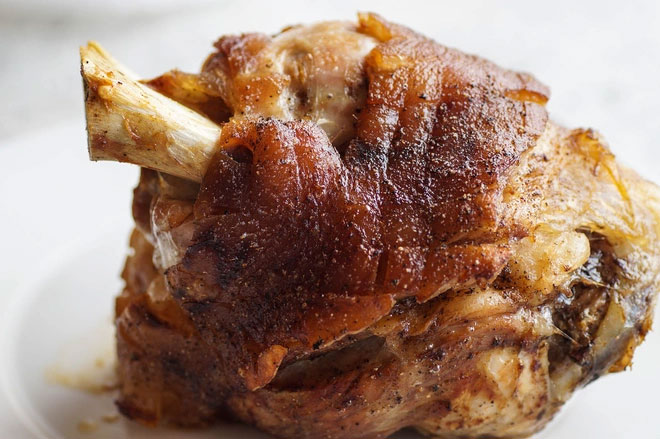While supporting joint movements, pig trotters cannot replace medication for degenerative conditions.
According to traditional wisdom, pig trotters offer numerous health benefits. Notably, they help joints function smoothly and can increase milk production in postpartum women.
No Medicinal Effects
In an interview, Associate Professor Dr. Nguyen Duy Thinh, former lecturer at the Institute of Biotechnology and Food Technology, Hanoi University of Science and Technology, stated that the gelatinous and sticky texture of pig trotters often leads to claims of their positive effects on joint health.
“In reality, pig trotters contain a high level of collagen, which helps increase synovial fluid in the joints, aiding in body movements,” the expert explained.

Dishes made from pig trotters help increase joint lubrication but cannot cure diseases. (Image source: izzycooking).
However, Professor Thinh emphasized that pig trotters or trotters are still a type of food and not medicine. Therefore, for cases of joint degeneration, patients should seek medical attention for proper diagnosis and treatment.
He stressed: “Supplementing with pig trotters only provides support; it does not cure the disease.”
Professor Thinh further explained that collagen is essentially a type of protein that enhances skin elasticity. Thus, in addition to supporting increased synovial fluid in the joints, the collagen found in pig trotters also helps improve skin elasticity and smoothness, especially in cases of dry or rough skin.
Milk Production Benefits but Requires Caution
Besides supporting increased synovial fluid in the joints, pig trotters are also believed to stimulate milk production, making them suitable for postpartum women who are breastfeeding.
“The primary components of pig trotters are protein, fat, calcium, iron, vitamins A, B, C, and particularly, the trotters contain a lot of gelatinous protein. This part is considered to stimulate milk production, but in reality, it may not be effective for everyone,” said Professor Nguyen Duy Thinh.
Regarding this issue, Dr. Nguyen Trong Hung, a specialist in obstetrics at Ha Dong General Hospital (Hanoi), noted that studies have shown certain foods can promote milk production, such as fenugreek seeds, moringa leaves, and pig trotters. However, relying solely on pig trotters for postpartum nutrition is inaccurate.

Postpartum women should not overly focus on eating pig trotters, as it can lead to micronutrient imbalance. (Image source: Culturetrip).
“Focusing too much on these foods can cause nutritional imbalances, leading to a deficiency of other micronutrients in breast milk. Additionally, mothers risk obesity and high blood lipids,” Dr. Trong Hung added.
The best dietary regimen for breastfeeding women is a varied diet that includes about 10-15 different foods, ensuring coverage of the four main nutrient groups: carbohydrates, fats, proteins, vitamins, and minerals.
In addition to the benefits for milk production, pig trotters are high in fat. Therefore, breastfeeding women should also include protein, carbohydrates, and fruits rich in vitamins to maintain nutritional balance.
Moreover, Dr. Hung recommends several other methods to enhance milk production:
Increase meal frequency and diversify food: Mothers should increase the number of meals throughout the day to ensure adequate energy for themselves and support milk production. However, it’s essential to keep portion sizes moderate to avoid excessive energy intake leading to obesity.
Breastfeeding women should also supplement necessary micronutrients like iron and vitamin A, which are significantly depleted during childbirth due to blood loss.
Ensure adequate sleep: In addition to avoiding stimulants like alcohol, beer, and tobacco, mothers should arrange for proper rest periods.
“Many mothers experience insomnia in the early stages of caring for their child. This is one of the leading causes of reduced milk supply in breastfeeding women. When overly stressed, mothers may face psychological inhibition, affecting their milk production,” Dr. Trong Hung observed.
Follow healthcare professionals’ guidance: Typically, postpartum women receive instructions from healthcare staff on breastfeeding techniques and important considerations. However, many overlook these guidelines.
According to the obstetrics specialist, mothers should ensure their babies finish breastfeeding. If the baby does not empty the breast, mothers must express the remaining milk. Failing to fully breastfeed can lead to engorgement, causing a gradual decrease in milk supply over time. This is because the milk ducts are not stimulated to produce more milk.


















































